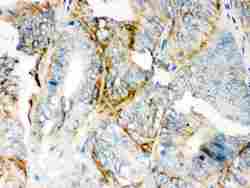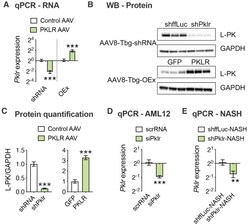Antibody data
- Antibody Data
- Antigen structure
- References [1]
- Comments [0]
- Validations
- Immunohistochemistry [1]
- Other assay [1]
Submit
Validation data
Reference
Comment
Report error
- Product number
- PA5-79824 - Provider product page

- Provider
- Invitrogen Antibodies
- Product name
- PKLR Polyclonal Antibody
- Antibody type
- Polyclonal
- Antigen
- Synthetic peptide
- Description
- Reconstitute with 0.2 mL of distilled water to yield a concentration of 500 µg/mL. Positive Control - WB: human HepG2 whole cell, rat liver tissue, mouse liver tissue. IHC: human intestinal cancer tissue.
- Reactivity
- Human, Mouse, Rat
- Host
- Rabbit
- Isotype
- IgG
- Vial size
- 100 μg
- Concentration
- 500 μg/mL
- Storage
- -20°C
Submitted references Liver Pyruvate Kinase Promotes NAFLD/NASH in Both Mice and Humans in a Sex-Specific Manner.
Chella Krishnan K, Floyd RR, Sabir S, Jayasekera DW, Leon-Mimila PV, Jones AE, Cortez AA, Shravah V, Péterfy M, Stiles L, Canizales-Quinteros S, Divakaruni AS, Huertas-Vazquez A, Lusis AJ
Cellular and molecular gastroenterology and hepatology 2021;11(2):389-406
Cellular and molecular gastroenterology and hepatology 2021;11(2):389-406
No comments: Submit comment
Supportive validation
- Submitted by
- Invitrogen Antibodies (provider)
- Main image

- Experimental details
- Immunohistochemistry analysis of PKLR on paraffin-embedded human intestinal cancer tissue. Sample was incubated with PKLR polyclonal antibody (Product# PA5-79824).
Supportive validation
- Submitted by
- Invitrogen Antibodies (provider)
- Main image

- Experimental details
- Figure 2 AAV-mediated modulation of hepatic L-PK expression. Eight-week-old male C57BL/6J mice were injected with either loss-of-function (shffLuc or shPklr) or gain-of-function (green fluorescent protein or PKLR) AAV vectors under the control of Tbg promoter and fed HF/HS diet for 17 additional weeks. ( A ) qPCR analyses of hepatic Pklr expression and ( B ) immunoblot analyses of hepatic PKLR in L-PK KD and OEx mice. GAPDH was used as a loading control. ( C ) Quantification of average PKLR levels normalized to GAPDH for each group. qPCR analyses of Pklr expression ( D ) 48 hours after siRNA transfection of AML12 cells (experiment was repeated 2 independent times with n = 3 wells per group each time) and ( E ) 12 weeks after NASH diet in L-PK KD mice. Data are presented as mean +- SEM (n = 6-8 livers for RNA and 3 for protein analyses per group). P values were calculated by unpaired Student t test. *** P < .001.
 Explore
Explore Validate
Validate Learn
Learn Western blot
Western blot Immunohistochemistry
Immunohistochemistry